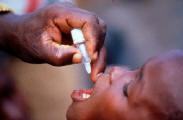|
17 Nov.
afternoon – Directorate
of Public Health and Preventative Medicine
C’s Notes from our conference with:
Dr. S. Murugan, Director of Public Health and
Preventive Medicine for the government of Tamil Nadu,
Dr. K. Subramani, Joint Director of Immunisation for the gov. of
Tamil Nadu,
Dr. K. Surendra, Sureillance Medical Officer for the National
Polio Surveillance Project of the WHO and government of India
(Add’l note – our meeting was videotaped by Terry
Lowe, independent filmmaker working on a documentary about
humanitarian aid, peace, and polio eradication in Tamil Nadu in
hopes that the film will be broadcast by the CBC.) –
This facility is responsible for handling
measles, malaria and tuberculosis, as well as polio, in the
Chennai area.
They have made great strides in the area of polio
arrestation (not really polio eradication – goal is to stop
children from contracting polio, even if the virus is not be
wiped out), and have had only one case of polio in the past few
years.
High risk areas for polio – slums, border areas,
new settlements (immigrant workers), remote areas, polio
case-reported areas, areas with poor surveillance. Diligence in
immunization is particularly needed because of the high birth
rate.
The Chief Minister (whose picture is on
billboards, etc.) has initiated a huge campaign to educate
families to have their children immunized. Public awareness is
increased through billboards, posters, danglers, banners,
education, etc.
Why program is called Pulse Polio – Vaccine is
given to the population at regular intervals, the way a pulse
beats (instead of continually providing the vaccine to a few
people each day).
Next stop: Rotary Centre in the Air India
building
Presentation by Dr. Raja Meenakshi,
People’s Project Coordinator, Pulse Polio Immunisation Programme
covering the city of Chennai. (Powerpoint presentation included
slides of statistics and a logo for kicking polio out of India.)
The District Familiy Welfare Medical Ofice of
Pulse Polio (government) works hand-in-hand) with Rotarians.
Chennai has a population of 4.8 million. The city is divided
into 10 zones, each with 10-12 health posts, and a total of 1126
polio booths.
Reasons number of cases of polio are being
reduced in the Chennai area – sanitation is getting better and
there is slightly less crowding.
Additional speeches –
Responsibitities of Rotary clubs in the
immunization program:
Vaccine procurement
Publicity
Banner and poster printing
Mobilization
Food
Other groups are responsible for telecasts and
broadcasts. The railway department hosts booths at train
stations for 2-4 days per each NID. These booths have a minimum
of four people – 1 to give drops, 1 to put purple marking on
finger, record keeper and 1 to gather children
Dr. CSR
on the history of Rotary’s involvement in the project –
Rotary made the vaccine available to the people of India.
Initially, there was resistance to immunization
by the fathers. While Rotarians and health workers could educate
mothers about the program, fathers were at work and weren’t
available to be educated. Rotary asked the most popular film
stars to create a film about polio immunization. The beautiful
actress, Menorama, idolized by the men, convinced the male
population to have their children immunized, and for a while the
vaccine became known as “Menorama drops.” The actor, Rajnikanth,
also played a large part in the film.
The next challenge to overcome was resistance
because of religious differences and fear of sterilization.
Rotary’s personal contacts helped break through barriers and
educate people about the safety of the vaccine.
The next step was to educate unmarried women.
The girls were taught that after they were married and had
children, first the babies were to be given “the drops,” then
milk. After the girls got married, they insisted that their
children be immunized, even to the point that they would stand
up to any resistance from their husbands.
Finally, they began to educate teachers. They ran
seminars on other subjects and worked in education about polio
eradication. They talked about the success in the U.S. and how
it was polio free to convince teachers of the importance of the
project.
In addition to cultural challenges, Rotary, WHO,
UNICEF and the government solved other problems. In India’s hot
climate, some of the vaccine was spoiling as it sat in the sun.
They couldn’t tell if the vaccine was getting overheated (and
therefore, becoming useless), so a special vial was invented
that had a border that changed color if the vaccine got warm.
Those administering the drops were taught to keep the vaccine in
the cooler or in a cup of ice and to check the color of the vial
before administering a dose. In each batch, one vial of vaccine
is sent back to the lab to make sure it’s still potent.
Still, they work to overcome challenge of
transient laborers who change locations and geographic areas
that are inaccessible during the monsoon season. Rotary has
responded to all these challenges by providing more hands.
Rotary will continue to work on the project until
the goal of arresting polio’s transmission is achieved.
District Chairperson for Polio Plus
What has increased the program’s success recently
is the formation of teams, each with doctors, nurses and
Rotarians. The team members became acquainted with each other
and attended a seminar together. They learned how best to
support one another.
Further publicity – blasting NID announcements
(with requests for mothers to have their children immunize).with
top songs in the background, banners, etc.
This year there has been participation by all
avenues of Rotary –
Inner Wheel – responsible for mobile units at
locations like bus stops and train stations (set up booths and
administer the drops)
Rotaract and Interact – lead children as they get
off trains or buses to the booth at the platform |

![]()
